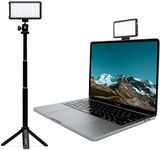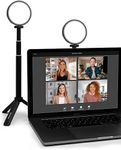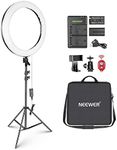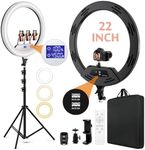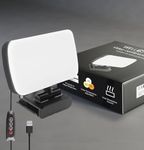Buying Guide for the Best Ring Lights
Choosing the right ring light can make a big difference in how your photos and videos look, whether you're creating content for social media, doing makeup, or joining video calls. The key is to match the features of the ring light to your specific needs, such as the type of work you do, the space you have, and how portable you need it to be. Understanding the main specifications will help you make a smart choice that improves your lighting and overall results.Diameter (Size)The diameter of a ring light refers to how wide the light is from one side to the other. This is important because a larger ring light spreads light more evenly and covers a bigger area, which is great for full-face or upper-body shots. Smaller ring lights are more portable and work well for close-up tasks like makeup or small product photography. If you need to light up a whole scene or want softer shadows, go for a larger size. If you need something compact for travel or desk use, a smaller diameter will be more convenient.
Brightness (Lumens or Adjustable Levels)Brightness tells you how much light the ring light can produce. Some ring lights have fixed brightness, while others let you adjust the intensity. Adjustable brightness is useful because it lets you control how much light you need for different situations, like dimming for softer looks or increasing for clear, sharp images. If you work in different lighting conditions or want more control, choose a ring light with adjustable brightness. If you always use it in the same setting, a fixed-brightness model might be enough.
Color TemperatureColor temperature describes the color of the light, ranging from warm (yellowish) to cool (bluish) tones, usually measured in Kelvins (K). This matters because different tasks and environments look better with different light colors. Adjustable color temperature lets you switch between warm and cool light, which is helpful for matching your lighting to the time of day or the mood you want. If you want natural-looking skin tones or need flexibility, look for a ring light with adjustable color temperature. If you only need one type of light, a fixed color temperature may be fine.
Power SourceRing lights can be powered by USB, batteries, or wall outlets. This affects where and how you can use the light. USB-powered lights are convenient for use with computers or portable chargers, making them good for travel or desk setups. Battery-powered lights are fully portable but need recharging or battery changes. Wall-powered lights are best for longer sessions in one place. Think about where you'll use your ring light most often to decide which power source fits your lifestyle.
Mounting OptionsMounting options refer to how and where you can set up your ring light. Some come with tripods, desk clamps, or flexible arms, while others are designed to attach to cameras or smartphones. The right mounting option depends on your workspace and how you plan to use the light. If you need to move it around or use it at different heights, a tripod or adjustable stand is helpful. For fixed setups, a clamp or arm might save space. Consider your typical setup to choose the most convenient mounting style.
Compatibility and AccessoriesSome ring lights come with extra features like phone holders, remote controls, or diffusers. Compatibility with your devices (like smartphones or cameras) and included accessories can make your experience smoother and more versatile. If you plan to use your ring light for selfies, video calls, or content creation, look for models that include holders or remotes. If you want softer light, a diffuser is a useful accessory. Think about what you'll use the ring light for and pick one with the right extras.
